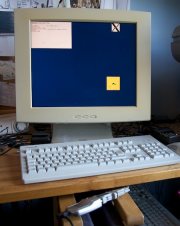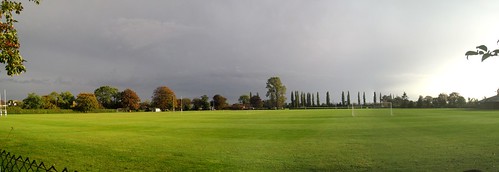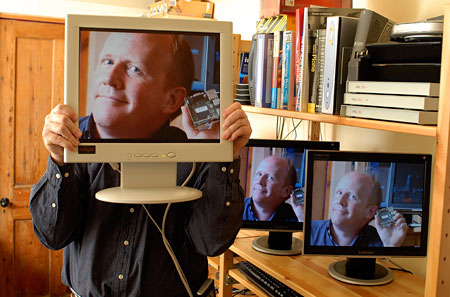It’s almost exactly 10 years since we started the Ndiyo project, with the aim of providing computing access to people for something “closer to the cost of a VGA lead than the cost of a computer”. Ndiyo has now formally closed, but it led to many other activities, including the founding of DisplayLink, and successful past projects in collaboration with the GSM Association, No-PC, and others.
Today, there’s some more good news.
Towards the end of Ndiyo’s life we started to experiment with a model we called ‘Hubster‘ – the name coming from using a USB hub as the core of a thin-client terminal, something made possible once DisplayLink’s evolution of the Ndiyo technology allowed monitors, as well as keyboards and mice, to be connected over USB. The idea is to share the power, cost, and the carbon footprint of a PC between two or more users at once, simply by plugging in enough USB peripherals to give the extra users access to it. This is important for everybody, but especially for the poorer parts of the world where the cost of owning one PC per person is prohibitive.
Well, over the last few years, Bernie Thompson at Plugable.com in Seattle has been beavering quietly away to make this more of a reality, by providing DisplayLink-based terminals at reasonable prices and by maintaining the Open Source software to drive them. There are two bits of good news coming from his recent efforts:
- First, he’s been working with RedHat to get support for USB terminals built in to the standard distribution of Fedora 17. We’re getting very close now to the ideal situation where you can turn any Linux box into a multi-user box simply by plugging in enough components for a new user, and a new login prompt will appear when you do so. Imagine, say, a disaster-relief information centre where one person with a laptop connected to a satellite link can easily provide access for half a dozen members of the team just by plugging them in. And it’s all Open Source. Zero extra software cost per user.
- Secondly, in an attempt to get the cost of these terminals down and support ongoing development of the Open Source components, he’s launched a Kickstarter project called ‘The $50 Computer‘.
Some may, quite sensibly, ask how this compares to the RaspberryPi, which is, after all, even cheaper, and is a standalone machine. Well, this one comes with a box!
No, seriously, they are both excellent projects – I have a RaspberryPi on order, too – but they fill different roles. RaspberryPi, in the early years at least, will be about teaching people the basics of how computing works.
Bernie and the Plugable team are creating a system where providing fully-featured applications to multiple users at very low cost is something that a non-technical user can do simply by plugging in USB devices.
In some situations, perhaps in an internet cafe, you may just want to give extra users access to a Chrome browser. But with this system you also have the option of providing them with OpenOffice, with Scrivener, with Blender, with Corel Aftershot Pro, with Sublime Text, with Skype, with… well you get the idea! And, of course, with access to however many giga- or terabytes of storage you care to put in the PC.
I think the Kickstarter plan is a great one – I wish it had been around when we started Ndiyo.
Please support it if you can… Even if you don’t need more affordable computing devices, for your kids, your school, your internet cafe, your office, there are millions who do. Billions, in fact.
Every $10 we can shave off the cost of access to IT makes it accessible to many thousands of new people globally… and now you have a chance to help.


 That, at least, is the verdict of
That, at least, is the verdict of  I was invited to give a talk on
I was invited to give a talk on 

Recent Comments